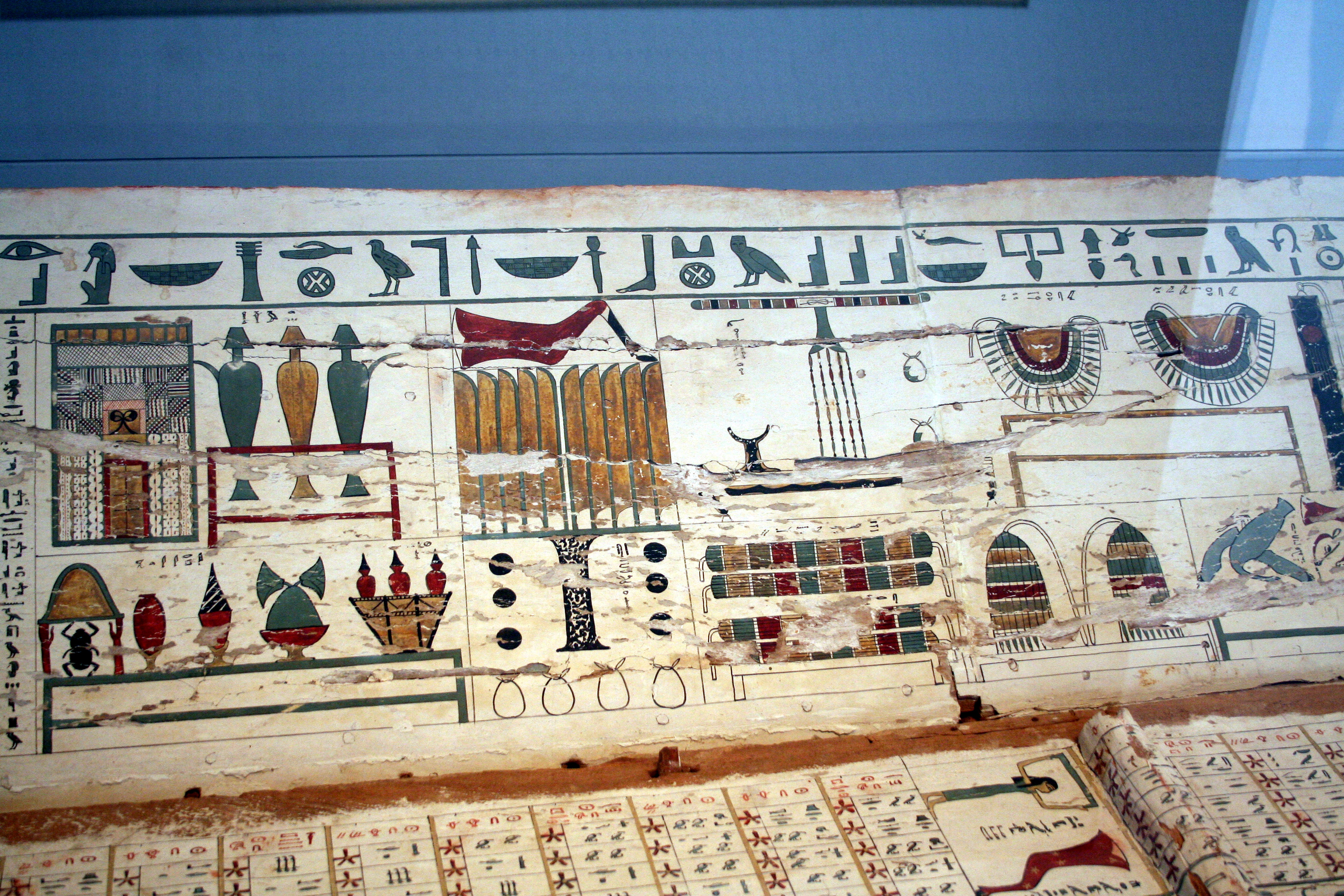|
Decans
The decans (; Egyptian ''bꜣktw'' or ''baktiu'', "hoseconnected with work") are 36 groups of stars (small constellations) used in the ancient Egyptian astronomy to conveniently divide the 360 degree ecliptic into 36 parts of 10 degrees each, both for theurgical and heliacal horological purposes. The decans each appeared, geocentrically, to rise consecutively on the horizon throughout each daily Earth rotation. The rising of each ''decan'' marked the beginning of a new decanal "hour" (Greek ''hōra'') of the night for the ancient Egyptians, and they were used as a sidereal star clock beginning by at least the 9th or 10th Dynasty (c. 2100 BCE). Because a new decan also appears heliacally every ten days (that is, every ten days, a new decanic star group reappears in the eastern sky at dawn right before the Sun rises, after a period of being obscured by the Sun's light), the ancient Greeks called them ''dekanoi'' (δεκανοί; pl. of δεκανός ''dekanos'') or "tenths". ... [...More Info...] [...Related Items...] OR: [Wikipedia] [Google] [Baidu] |
Decan (astrology)
In astrology, a ''decan'' is the subdivision of a sign. In order to give fuller interpretation to the zodiac signs, ancient astrologers subdivided each sign into periods of approximately ten days. These divisions are known as the "decans" or "decanates" and cover modifications of individual traits, attributed to minor planetary influences, which temper or blend with the ruling influence of the period. The ten-day spans are somewhat arbitrary in order to allow for the five (and sometimes six) extra days in the year beyond the 360 days required for the thirty-six decans. Each sign is allocated a triplicity, consisting of three of the four classical elements air, water, earth or fire, and is therefore subdivided into three equal parts of 10 degrees each; these parts are referred to as ''decans'' or ''decanates''. Each decan of a sign is assigned Domicile (astrology), rulership by the planet ruling the sign and secondary rulership by the planet ruling the decan. In Ptolemy The deca ... [...More Info...] [...Related Items...] OR: [Wikipedia] [Google] [Baidu] |
Hellenistic Astrology
Hellenistic astrology is a tradition of horoscopic astrology that was developed and practiced in the late Hellenistic period in and around the Mediterranean Basin region, especially in Egypt. The texts and technical terminology of this tradition of astrology were largely written in Greek (or sometimes Latin). The tradition originated sometime around the late 2nd or early 1st century BCE, and then was practiced until the 6th or 7th century CE. This type of astrology is commonly referred to as "Hellenistic astrology" because it was developed in the late Hellenistic period, although it continued to be practiced for several centuries after the end of what historians usually classify as the Hellenistic era. History The origins of much of the astrology that would later develop in Asia, Europe and the Middle East are found among the ancient Babylonians and their system of celestial omens that began to be compiled around the middle of the 2nd millennium BC, 2nd millennium BCE. This sys ... [...More Info...] [...Related Items...] OR: [Wikipedia] [Google] [Baidu] |
Book Of Nut
The ''Book of Nut'' (original title: ''The Fundamentals of the Course of the Stars'') is a collection of Ancient Egypt, ancient Egyptian astronomical texts focusing on mythological subjects, cycles of the stars of the decans, and the movements of the moon, sun, and planets on sundials. It is titled for the sky goddess Nut (goddess), Nut who is depicted in some copies of the text arching over the earth. She is supported by the god of the air Shu (Egyptian deity), Shu. Texts in the ''Book of Nut'' include material from different periods of Egyptian history. The original name of the book, ''The Fundamentals of the Course of the Stars'', was discovered by Alexandra von Lieven in one of the manuscript fragments and published in 2007. One of the major themes of the ''Book of Nut'' is the concept of sunrise as the mythological rebirth. Texts There are nine different copies of the book and they have various dates. Three copies are found on monuments and six more are found in the papy ... [...More Info...] [...Related Items...] OR: [Wikipedia] [Google] [Baidu] |
Hour
An hour (symbol: h; also abbreviated hr) is a unit of time historically reckoned as of a day and defined contemporarily as exactly 3,600 seconds ( SI). There are 60 minutes in an hour, and 24 hours in a day. The hour was initially established in the ancient Near East as a variable measure of of the night or daytime. Such seasonal hours, also known as temporal hours or unequal hours, varied by season and latitude. Equal hours or equinoctial hours were taken as of the day as measured from noon to noon; the minor seasonal variations of this unit were eventually smoothed by making it of the mean solar day. Since this unit was not constant due to long term variations in the Earth's rotation, the hour was finally separated from the Earth's rotation and defined in terms of the atomic or physical second. It is a non-SI unit that is accepted for use with SI. In the modern metric system, one hour is defined as 3,600 atomic seconds. However, on rare occasions an hour may inc ... [...More Info...] [...Related Items...] OR: [Wikipedia] [Google] [Baidu] |
Heliacal Rising
The heliacal rising ( ) of a star or a planet occurs annually when it becomes visible above the eastern horizon at dawn just before sunrise (thus becoming "the Morning Star (other)#Astronomy, morning star"). A heliacal rising marks the time when a star or planet becomes visible for the first time again in the night sky after having set with the Sun at the western horizon in a previous sunset (its heliacal setting), having since been in the sky only during daytime, obscured by sunlight. Historically, the most important such rising is that of Sirius, which was an important feature of the Egyptian calendar and Egyptian astronomy, astronomical development. The rising of the Pleiades heralded the start of the Ancient Greek sailing season, using celestial navigation, as well as the farming season (attested by Hesiod in his Works and Days). Heliacal rising is one of several types of risings and settings, mostly they are grouped into morning and evening risings and settings of obj ... [...More Info...] [...Related Items...] OR: [Wikipedia] [Google] [Baidu] |
Egyptian Astronomy
Egyptian astronomy started in prehistory, prehistoric times, in the Prehistoric Egypt, Predynastic Period. In the 5th millennium BCE, the stone circles at Nabta Playa may have made use of astronomical alignments. By the time the historical Ancient Egypt, Dynastic Period began in the 3rd millennium BCE, the 365 day period of the Egyptian calendar was already in use, and the observation of stars was important in determining the annual flooding of the Nile. The Egyptian pyramids were carefully aligned towards the pole star, and the temple of Amun, Amun-Re at Karnak was aligned on the rising of the winter solstice, midwinter Sun. Astronomy played a considerable part in fixing the dates of religious festivals and determining the hours of night, and temple astrology, astrologers were especially adept at watching the stars and observing the conjunction (astronomy), conjunctions and risings of the Sun, Moon, and planets, as well as the lunar phases. In Ptolemaic Kingdom, Ptolemaic ... [...More Info...] [...Related Items...] OR: [Wikipedia] [Google] [Baidu] |
Hermeticism
Hermeticism, or Hermetism, is a philosophical and religious tradition rooted in the teachings attributed to Hermes Trismegistus, a syncretism, syncretic figure combining elements of the Greek god Hermes and the Egyptian god Thoth. This system encompasses a wide range of Western esotericism, esoteric knowledge, including aspects of alchemy, astrology, and theurgy, and has significantly influenced various mystical and occult traditions throughout history. The writings attributed to Hermes Trismegistus, often referred to as the ''Hermetica'', were produced over a period spanning many centuries () and may be very different in content and scope. One particular form of Hermetic teaching is the religio-philosophical system found in a specific subgroup of Hermetic writings known as the Hermetica#Religio-philosophical Hermetica, 'religio-philosophical' ''Hermetica''. The most famous of these are the ''Corpus Hermeticum'', a collection of seventeen Ancient Greek, Greek treatises written b ... [...More Info...] [...Related Items...] OR: [Wikipedia] [Google] [Baidu] |
Testament Of Solomon
The Testament of Solomon is a pseudepigraphical composite text ascribed to King Solomon but not regarded as canonical scripture by Jews or Christian groups. It was written in the Greek language, based on precedents dating back to the early 1st millennium AD, but was likely not completed in any meaningful textual sense until sometime in the Middle Ages. In its most noteworthy recensions, the text describes how Solomon was enabled to build his temple by commanding demons by means of a magical ring that was entrusted to him by the archangel Michael. Dating and authorship Scholarly opinion on when the Testament of Solomon was written varies widely. Suggested dates for its composition range between the end of the 1st century AD and the High Middle Ages. Also disputed is whether it had a Christian or Jewish origin. Mid-twentieth century scholarship tended to agree that much of its content "reflects the first-century Judaism in Israel" and includes material much earlier than its com ... [...More Info...] [...Related Items...] OR: [Wikipedia] [Google] [Baidu] |
Wandering Stars
A classical planet is an astronomical object that is visible to the naked eye and moves across the sky and its backdrop of fixed stars (the common stars which seem still in contrast to the planets), appearing as wandering stars. Visible to humans on Earth there are seven classical planets (the seven luminaries). They are from brightest to dimmest: the Sun, the Moon, Venus, Jupiter, Mercury, Mars and Saturn. Greek astronomers such as Geminus and Ptolemy recorded these classical planets during classical antiquity, introducing the term ''planet'', which means 'wanderer' in Greek ( and ), expressing the fact that these objects move across the celestial sphere relative to the fixed stars. Therefore, the Greeks were the first to document the astrological connections to the planets' visual detail. Through the use of telescopes other celestial objects like the classical planets were found, starting with the Galilean moons in 1610. Today the term ''planet'' is used considerably diff ... [...More Info...] [...Related Items...] OR: [Wikipedia] [Google] [Baidu] |
Seti I
Menmaatre Seti I (or Sethos I in Greek language, Greek) was the second pharaoh of the Nineteenth Dynasty of Egypt during the New Kingdom of Egypt, New Kingdom period, ruling or 1290 BC to 1279 BC. He was the son of Ramesses I and Sitre, and the father of Ramesses II. The name 'Seti' means "of Set", which indicates that he was consecrated to the god Set (mythology), Set (also termed "Sutekh" or "Seth"). As with most pharaohs, Seti had several names. Upon his ascension, he took the Prenomen (Ancient Egypt), prenomen "mn-m3't-r' ", usually vocalized in Egyptian as ''Menmaatre'' (Established is the Justice of Re). His better known Nomen (Ancient Egypt), nomen, or birth name, is transliterated as "''sty mry-n-ptḥ"'' or ''Sety Merenptah'', meaning "Man of Set, beloved of Ptah". Manetho incorrectly considered him to be the founder of the 19th Dynasty, and gave him a reign length of 55 years, though no evidence has ever been found for so long a reign. Reign Background After th ... [...More Info...] [...Related Items...] OR: [Wikipedia] [Google] [Baidu] |
Vettius Valens
Vettius Valens (120 – c. 175) was a 2nd-century Hellenistic astrologer, a somewhat younger contemporary of Claudius Ptolemy. Valens' major work is the ''Anthology'' (), ten volumes in Greek written roughly within the period 150 to 175. The ''Anthology'' is the longest and most detailed treatise on astrology which has survived from that period. A working professional astrologer, Valens includes over a hundred sample charts from his case files in the ''Anthology''. Life Although originally a native of Antioch, he appears to have travelled widely in Egypt in search of specific astrological doctrines to bolster his practice. At the time Alexandria was still home to a number of astrologers of the older Babylonian, Greek and Egyptian traditions. He published much of what he learned from the tradition and through his practice in his ''Anthology'', written in an engaging and instructional style. The ''Anthology'' is thus of great value in piecing together actual working technique ... [...More Info...] [...Related Items...] OR: [Wikipedia] [Google] [Baidu] |



